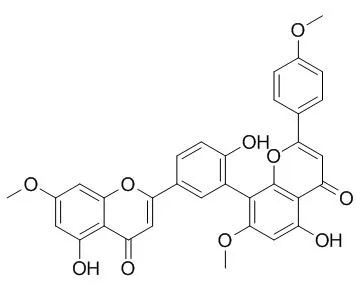| In vitro: |
| Phytochem Anal. 2014 Mar-Apr;25(2):127-33. | | Preparative isolation of six anti-tumour biflavonoids from Selaginella doederleinii Hieron by high-speed counter-current chromatography.[Pubmed: 24115163] |
Biflavonoids are the primary constituents of Selaginella doederleinii Hieron, to which different bioactivities have been attributed, including anti-cancer, anti-inflammatory, anti-oxidant, anti-fungal and anti-virus activity. However, effective methods for separation of these compounds are not currently available.
To develop a high performance and bioassay-guided method for preparative isolation of biflavonoids from S. doederleini via high-speed counter-current chromatography (HSCCC).
METHODS AND RESULTS:
The anti-proliferation effects of four fractions (70% ethanol, petroleum ether, dichloromethane and acetic ether extracts) of S. doederleinii on five human cancer cells were monitored. The dichloromethane and acetic ether extracts showed good cytotoxicities to the studied cancer cell lines, guiding the subsequent separation. Two solvent systems composed of n-hexane:ethyl acetate:methanol:water (1:2:1.5:1.5, v/v) and n-hexane:ethyl acetate:methanol:water (3:2:3:2, v/v) were developed for separation of the active fractions, respectively. Identification of the biflavonoids was performed by EI-MS(n) , (1) H- and (13) C-NMR.
Under the optimised conditions, 12.6 mg amentoflavone (91.4%), 6.6 mg robustaflavone (90.4%), 7.5 mg 2'', 3''-dihydro-3', 3'''-biapigenin (98.2%) and 7.3 mg 3', 3'''-binaringenin (90.3%) from acetic ether extract (500 mg) and 6.3 mg Heveaflavone (93.5%) and 5.3 mg 7, 4', 7'', 4'''-tetra-O-methyl-amentoflavone (94.5%) from dichloromethane extract (200 mg) were obtained, respectively. The anti-proliferation effects of the six biflavonoids on the five human cancer cells were further verified.
CONCLUSIONS:
The study provides methodological references for simultaneously preparative isolation of several bioactive biflavones from the herbal family of Selaginella. It is the first report discovering 2'', 3''-dihydro-3', 3'''-biapigenin and 3', 3'''-binaringenin from this herb and describing their cytotoxicities to human cancer cell lines. | | J Tradit Complement Med. 2012 Jul;2(3):220-6. | | Naturally Occurring Cytotoxic [3'→8″]-Biflavonoids from Podocarpus nakaii.[Pubmed: 24716136] |
METHODS AND RESULTS:
Bioassay-guided fractionation of the EtOH extract of the dried twigs of Podocarpus nakaii Hayata (Podocarpaceae), endemic plant in Taiwan has resulted in isolation of four [3'→8″]-biflavonoid derivatives, amenotoflavone (AF), podocarpusflavone-A (PF), II-4″,I-7-dimethoxyamentoflavone (DAF), and Heveaflavone (HF). Their structures were determined by physical and extensive spectroscopic analyses such as (1)H, (13)C, (1)H-(1)H COSY, HMQC, and HMBC, as well as comparison with literature values.
CONCLUSIONS:
Compounds PF and DAF showed significant inhibitions against DLD, KB, MCF-7, HEp-2 tumor cell lines (ED50 ca. 4.56-16.24 μg/mL) and induced cell apoptosis in MCF-7 via mainly sub-G1/S phase arrest. Furthermore, these compounds exhibited moderate Topoisomerase I inhibitory activity. |
|






 Cell. 2018 Jan 11;172(1-2):249-261.e12. doi: 10.1016/j.cell.2017.12.019.IF=36.216(2019)
Cell. 2018 Jan 11;172(1-2):249-261.e12. doi: 10.1016/j.cell.2017.12.019.IF=36.216(2019) Cell Metab. 2020 Mar 3;31(3):534-548.e5. doi: 10.1016/j.cmet.2020.01.002.IF=22.415(2019)
Cell Metab. 2020 Mar 3;31(3):534-548.e5. doi: 10.1016/j.cmet.2020.01.002.IF=22.415(2019) Mol Cell. 2017 Nov 16;68(4):673-685.e6. doi: 10.1016/j.molcel.2017.10.022.IF=14.548(2019)
Mol Cell. 2017 Nov 16;68(4):673-685.e6. doi: 10.1016/j.molcel.2017.10.022.IF=14.548(2019)